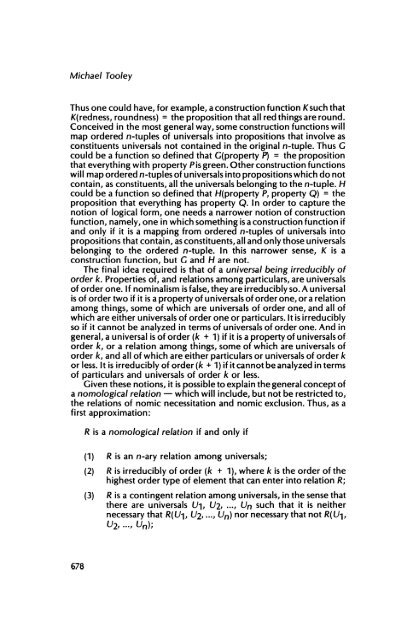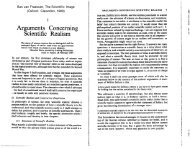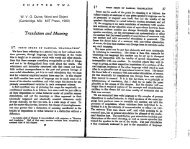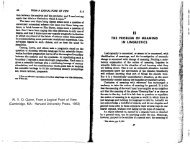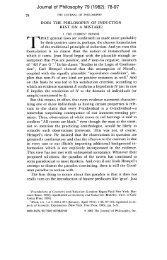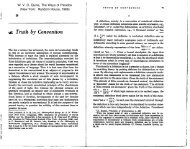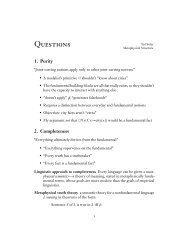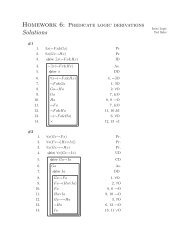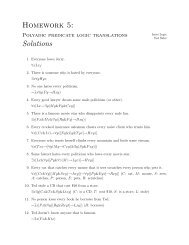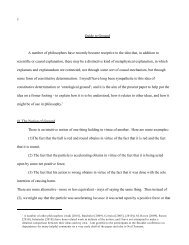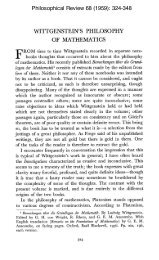Tooley - the nature of laws.pdf - Ted Sider
Tooley - the nature of laws.pdf - Ted Sider
Tooley - the nature of laws.pdf - Ted Sider
Create successful ePaper yourself
Turn your PDF publications into a flip-book with our unique Google optimized e-Paper software.
Michael <strong>Tooley</strong><br />
Thus one could have, for example, a construction function Ksuch that<br />
K( redness, roundness) = <strong>the</strong> proposition that all red things are round.<br />
Conceived in <strong>the</strong> most general way, some construction functions will<br />
map ordered n-tuples <strong>of</strong> universal into propositions that involve as<br />
constituents universals not contained in <strong>the</strong> original n-tuple. Thus C<br />
could be a function so defined that C(property P) = <strong>the</strong> proposition<br />
that everything with property Pis green. O<strong>the</strong>r construction functions<br />
will map ordered n-tuples <strong>of</strong> universals into propositions which do not<br />
contain, as constituents, all <strong>the</strong> universals belonging to <strong>the</strong> n-tuple. H<br />
could be a function so defined that /-/(property P, property Q) = <strong>the</strong><br />
proposition that everything has property Q. In order to capture <strong>the</strong><br />
notion <strong>of</strong> logical form, one needs a narrower notion <strong>of</strong> construction<br />
function, namely, one in which something is a construction function if<br />
and only if it is a mapping from ordered n-tuples <strong>of</strong> universals into<br />
propositions that contain, as constituents, all and only those universals<br />
belonging to <strong>the</strong> ordered n-tuple. In this narrower sense, K is a<br />
construction function, but C and H are not.<br />
The final idea required is that <strong>of</strong> a universal being irreducibly <strong>of</strong><br />
order k. Properties <strong>of</strong>, and relations among particulars, are universals<br />
<strong>of</strong> order one. If nominalism is false, <strong>the</strong>y are irreducibly so. A universal<br />
is <strong>of</strong> order two if it is a property <strong>of</strong> universals <strong>of</strong> order one, or a relation<br />
among things, some <strong>of</strong> which are universals <strong>of</strong> order one, and all <strong>of</strong><br />
which are ei<strong>the</strong>r universals <strong>of</strong> order one or particulars. It is irreducibly<br />
so if it cannot be analyzed in terms <strong>of</strong> universals <strong>of</strong> order one. And in<br />
general, a universal is <strong>of</strong> order (k + 1) if it is a property <strong>of</strong> universals <strong>of</strong><br />
order k, or a relation among things, some <strong>of</strong> which are universals <strong>of</strong><br />
order k, and all <strong>of</strong> which are ei<strong>the</strong>r particulars or universals <strong>of</strong> order k<br />
or less. It is irreducibly <strong>of</strong> order (Ic + 1) if it cannot be analyzed in terms<br />
<strong>of</strong> particulars and universals <strong>of</strong> order k or less.<br />
Given <strong>the</strong>se notions, it is possible to explain <strong>the</strong> general concept <strong>of</strong><br />
a nomological relation - which will include, but not be restricted to,<br />
<strong>the</strong> relations <strong>of</strong> nomic necessitation and nomic exclusion. Thus, as a<br />
first approximation:<br />
678<br />
R is a nomological relation if and only if<br />
(1)<br />
(2)<br />
R is an n-ary relation among universals;<br />
R is irreducibly <strong>of</strong> order (k + 1), where k is <strong>the</strong> order <strong>of</strong> <strong>the</strong><br />
highest order type <strong>of</strong> element that can enter into relation R;<br />
(3) R is a contingent relation among universals, in <strong>the</strong> sense that<br />
<strong>the</strong>re are universals Oj, U2, ..., Un such that it is nei<strong>the</strong>r<br />
necessary that R(l>|, U2, •••> ^n) nor necessary that not R(U-\,<br />
U2, ..., Un);


